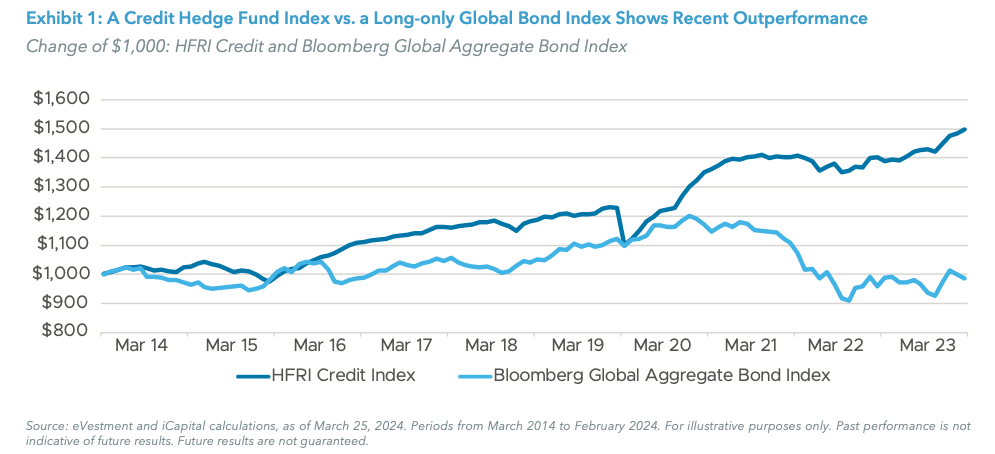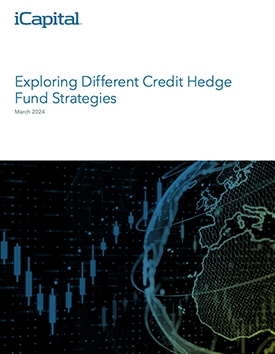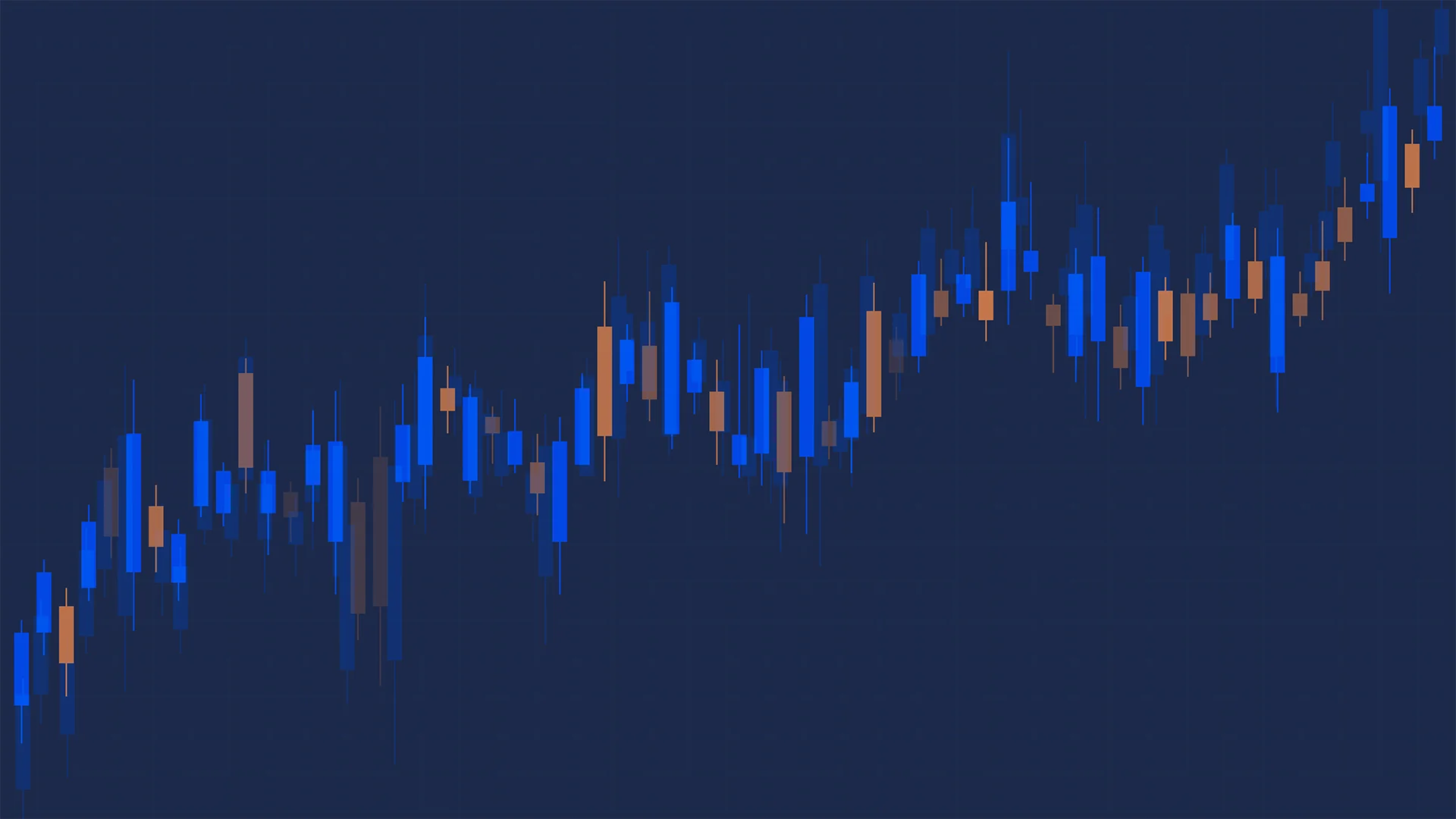CREDIT HEDGE FUND STRATEGY OVERVIEW
There are three main types of credit hedge fund strategies: Long/Short, Securitized, and Distressed.
Long/Short
These hedge funds take long and short positions in a security, an industry, or a market to express a view that certain investments will move positively (long) or negatively (short). A long/short credit hedge fund takes this approach in underlying fixed-income instruments.
There are several ways a long/short credit hedge fund can be used to express an investment thesis. A manager could go long and short in credit instruments of the same company with different maturities, for example buying (long) a company’s one-year bond and selling (short) its 10-year bond, if the manager believes the credit worthiness of the company is stronger near-term but riskier in the future.
This is typically referred to as a capital structure trade. A manager may also take long and short positions in different credit instruments, perhaps buying a corporate bond and shorting a credit index, to express a view that a particular company’s credit will outperform a broader universe of credit securities. A third example is a relative value trade whereby the manager buys the debt of one company while shorting the debt of another company. This type of strategy is often used with issuers that are operating in the same industry with bonds having similar maturities, believing that the credit strength of one company is stronger than its peer.
Historically, long/short credit hedge funds tend to benefit from lower correlations and higher dispersion within the fixed income market, which provides an environment for greater return potential. We have seen higher interest rates impact companies quite differently over the last several years, leading to significant outperformance of a credit hedge fund index versus a long-only global bond index (Exhibit 1).
Securitized
Securitized credit instruments are fixed-income securities that are backed by portfolios of income-generating assets. Securitized credit managers aim to take advantage of pricing inefficiencies and periodic dislocations across structured credit instruments including mortgage-backed securities (MBS), asset-backed securities (ABS), and collateralized loan obligations (CLO).
In the U.S. alone, these securitized, or structured, credit instruments comprise a $12-plus trillion market that can provide exposure across a broad range of subsectors and asset types.1 However, despite its scale and breadth, the structured credit market tends to be relatively inefficient and underfollowed, providing a rich opportunity set for specialist managers who can navigate its complexity. Additionally, the floating rate nature of most structured credit instruments can be particularly appealing during periods of higher and/or rising interest rates. And while there is a deep and active secondary market for these securities, experienced managers can further add value by sourcing primary deals and negotiating favorable terms on transactions. Given this unique profile, structured credit exposure can help investors improve the risk/return potential of their overall portfolio by diversifying away from traditional fixed income markets.
Distressed
A distressed credit fund invests in the debt of companies that have filed for bankruptcy or have a significant chance of filing for bankruptcy in the near future, with the expectation that the company will ultimately recover from financial distress. Hedge fund managers can access distressed debt through the bond market, aiming to purchase these distressed bonds at a steep discount to their par value, or work directly with a distressed company to extend credit on behalf of the fund.
Often a company can avoid a formal bankruptcy (e.g., Chapter 11 in the U.S.) via a “selective default,” which differs from a general default because an issuer may have only defaulted on one or a portion of its debt obligations. It has been estimated that corporate default rates have increased at the fastest pace since 2009 with 15 defaults in February 2024, bringing the 2024 year-to-date count to 29, with selective defaults representing ~60% versus Chapter 11 filings comprising ~40%.2 Repeat defaults are more common following selective defaults, suggesting additional distressed activity for the issuer.3
Distressed credit hedge funds may acquire a substantial stake in a company’s bonds and actively participate in restoring financial viability, while others may provide funding directly to a company that faces near-term liquidity needs. While the opportunity for returns is high, distressed debt also carries a greater amount of risk. Investors should carefully diligence distressed debt hedge fund managers to understand their credit risk underwriting capabilities and expertise in debt restructurings and reorganizations.
CONCLUSION
From a portfolio perspective, credit hedge funds tend to deliver differentiated sources of fixed income exposure with less directionality and more unique sources of return. Low or near-zero interest rate environments can weigh on the performance of credit strategies. However, over the longer term, the strategy has proven to be more stable – with less volatility – relative to global bonds, generating positive relative performance for clients.
INDEX DEFINITIONS
Bloomberg Global Aggregate Bond Index: A flagship measure of global investment grade debt from a multitude local currency markets. This multi-currency benchmark includes treasury, government-related, corporate and securitized fixed-rate bonds from both developed and emerging markets issuers.
HFRI Credit Index: A composite index of strategies trading primarily in credit markets. It is an aggregation of following 7 HFRI substrategy indices. HFRI ED: Credit Arbitrage Index, HFRI ED: Distressed/Restructuring Index, HFRI ED: Multi-Strategy Index, HFRI RV: Fixed Income-Asset Backed Index, HFRI RV: Fixed Income-Convertible Arbitrage Index, HFRI RV: Fixed Income-Corporate Index, and HFRI RV: Multi-Strategy Index. For more information, visit HFRI Indices - Index Descriptions.
ENDNOTES
1. Barings, “Why Securitized & Why Now: $12.5 Trillion Market Goes on Sale,” Feb. 2023.
2. S&P Global Ratings, “Instant Insights: Key Takeaways From Our Research,” March 20, 2024.
3. S&P Global, “Buying Time Post-Default with Private Credit,” Nov. 30, 2023.



















